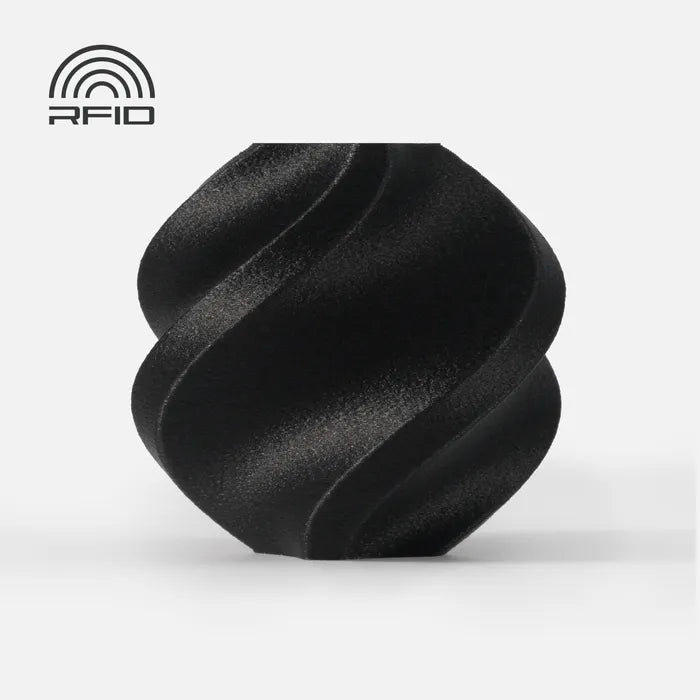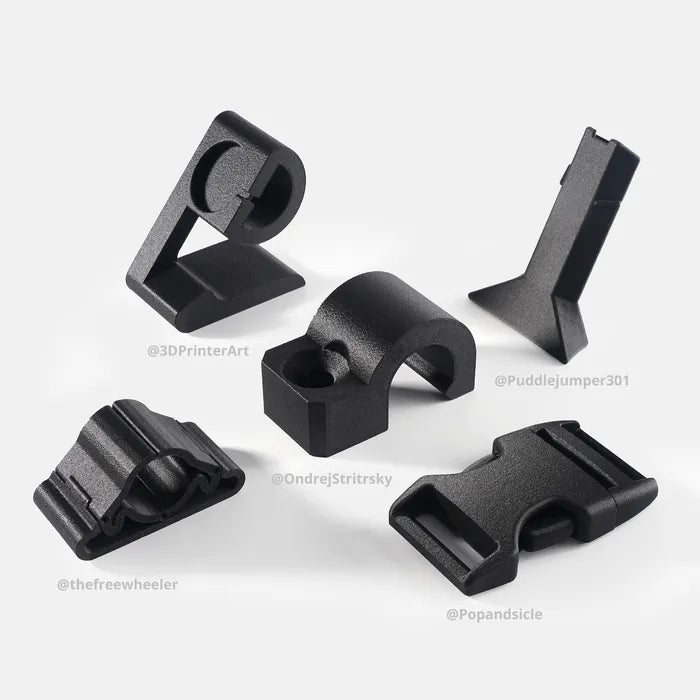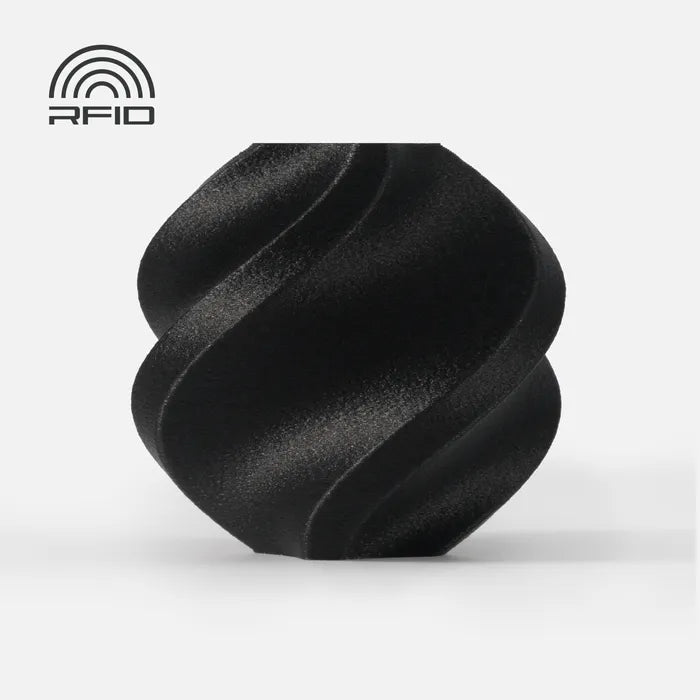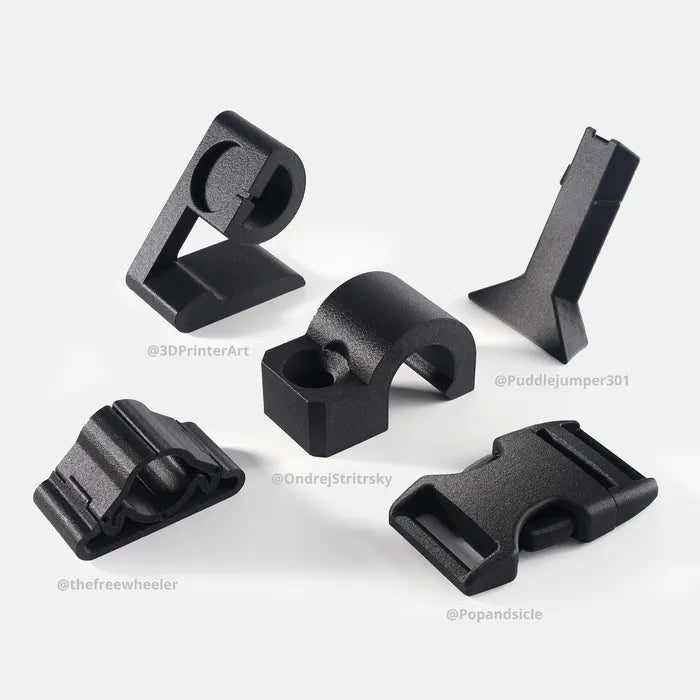

Bambu Lab PAHT-CF - Black (70100)
Bambu PAHT-CF
Bambu PAHT-CF is a composite of PA12 and carbon fiber. Inheriting the advantages of low water absorption from PA12 and high-performance carbon fiber, Bambu PAHT-CF offers excellent mechanical and thermal properties that can be maintained well even when the prints get wet. Higher Z adhesion layers and flexibility make it ideal for creating engineering parts such as functional prototypes, machining fixtures, injection molds, jigs, and low-volume production parts.
Low water absorption
With a 50% lower water absorption rate compared to normal PA-CF,
Bambu PAHT-CF maintains excellent mechanical properties and dimensional stability even when exposed to high humidity.
Mechanical Properties Comparison
| Normal PA-CF | PAHT-CF | |
| Saturated Water Absorption Rate/% ( 25 °C, 55% RH ) | 1.70 | 0.88 |
| Bending Strength - XY/MPa (Dry) | 128 | 125 |
| Bending Strength - XY/MPa (Wet) | 76 | 115 |
| Bending Strength - Z/MPa (Dry) | 48 | 61 |
| Bending Strength - Z/MPa (Wet) | 34 | 49 |
| Bending Modulus - XY/MPa (Dry) | 4420 | 4230 |
| Bending Modulus - XY/MPa (Wet) | 2210 | 3640 |
| Bending Modulus - Z/MPa (Dry) | 1470 | 1820 |
| Bending Modulus - Z/MPa (Wet) | 770 | 1480 |
| Decline rate of mechanical properties after absorbing water/% | 40%-45% | 12%-18% |
Exceptional Z-bonding
Bambu PAHT-CF shows much higher adhesion in Z layers compared to normal PA-CF,
bringing it the ability to withstand high levels of impact or stress without breaking or deforming.
Z-layer Performance
| Normal PA-CF | PAHT-CF | Improved % | |
| Bending Strength - Z/MPa | 48 | 61 | 27% |
| Bending Modulus - Z/MPa | 1470 | 1820 | 24% |
| Impact Strength - Z/(kJ/m²) | 5.7 | 13.3 | 133% |
*Both PA-CF and PAHT-CF need to be dried at 80 °C for 12 hours before printing.
High tensile strength
Bambu PAHT-CF is designed to meet the demands of various industrial
and engineering applications where high strength and durability are required.
Designed for high-temperature resistance
The heat deflection temperature of Bambu PAHT-CF is up to 194℃ (0.45MPa)*, making it useful in applications where the printed parts may be exposed to high temperatures without deforming or losing their strength.
*The long-term temperature resistance is related to the structure and usage scenario of the model itself.
Reusable spool
Bambu PAHT-CF comes with a high-temperature resistant spool, which is not prone to deformation in the drying process. Continuing our concept of reducing plastic waste, the spool can also be reused with other Bambu refills.
Product Features
- Low Moisture Absorption
- Exceptional Mechanical Properties & Layer Adhesion
- High Tensile Strength
- Comes with High Temperature Reusable Spool
- Diameter: 1.75mm +/- 0.03mm
Cautions for Use
- 0.6 mm Nozzle Recommended
- 0.2 mm Nozzle Not Compatible
- Stainless Steel Nozzle Not Recommended
- Dry before Use for the Highest Print Quality
- AMS Compatible
- AMS lite NOT Compatible
- Enclosure Printer Required
Recommended Printing Settings
| Drying Settings (Blast Drying Oven) | 80 °C, 8 - 12 h |
| Printing and Keeping Container's Humidity | < 20% RH (Sealed, with Desiccant) |
| Nozzle Temperature | 260 - 290 °C |
| Bed Temperature (with Glue) | 80 - 100 °C |
| Printing Speed | < 100 mm/s |
Physical Properties
| Density | 1.06 g/cm³ |
| Vicat Softening Temperature | 220 °C |
| Heat Deflection Temperature | 194 °C |
| Melting Temperature | 225 °C |
| Melt Index | 14.4 ± 2.0 g/10 min |
Mechanical Properties
| Tensile Strength | 92 ± 7 MPa |
| Breaking Elongation Rate | 8.4 ± 1.8 % |
| Bending Modulus | 4230 ± 210 MPa |
| Bending Strength | 125 ± 7 MPa |
| Impact Strength | 57.5 ± 3.4 kJ/m² |
Printing Tips
- Drying conditions: 80℃ for 8 hrs. PAHT-CF is highly sensitive to humidity. Further drying before use and after storage is recommended. Refer to Filament drying instructions on WIKI.
- Bambu PAHT-CF requires high thermal insulation during printing and is not suitable for open-frame printers.
- Remove support structures within 2 hours after printing to prevent sticking due to moisture. If sticking occurs, dry the model to ease removal.
- For improved results, refer to: Engineering material printing tips on WIKI.

